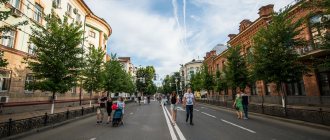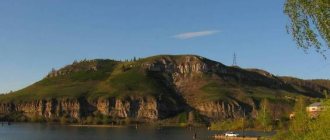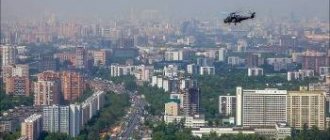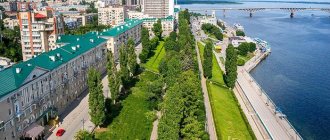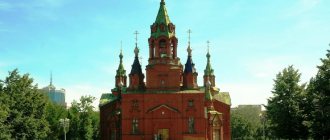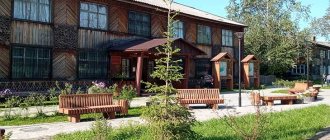The city of Tarusa in the Kaluga region fits on only 12 square kilometers. The population here does not even reach 10 thousand people.
The city gained fame thanks to poets, writers and artists who worked here at different times. Konstantin Paustovsky spent most of his life here, Marina Tsvetaeva came to the city for the summer in her childhood and youth. Poet Bella Akhmadulina was unable to buy an apartment in Tarusa; she rented housing here with her husband from 1974 until the collapse of the Union. The artist Vasily Polenov had a dacha in the city, where he spent a lot of time.
Creative personalities loved Tarusa for its privacy and patriarchy, which has survived into the 21st century. A significant part of the town’s attractions are associated with those who lived and worked here.
From Tarusa you can go to Serpukhov, 40 kilometers away (where there are not only temples and museums, but also real peacocks, ostriches and bison), or you can go to Kaluga, 80 kilometers away, for, for example, the Tsiolkovsky Museum.
Lenin Street and Square
The communist regime ended long ago, but the main street of the city retained the same name. The center of Tarusa is built up with cute one-story houses of the 19th-20th centuries.
The station building is located on Lenin Street, 2. Because of fears that the city would turn into an industrial one, the railway to Tarusa was never built. But the typical station of the early 20th century remains.
On Lenin Square, opposite the Peter and Paul Cathedral, there is a monument to Lieutenant General M.G. Efremov, a native of Tarusa.
Resurrection Church
After wandering along the civilian part of the embankment, we walk along the shore along Dekabristov Street. After crossing the bridge over the stream, we will see the Resurrection Church on the hill. Very old - built in the 16th century. By the way, the stream that you crossed on the bridge originates here from a holy spring. Previously, the entire city drew water from it. The water tastes good. Now there is a chapel next to it.
Cathedral of Peter and Paul
Address: Lenin Square Phone: +7 (48435) 2-51-88 Website: https://tarusa.cerkov.ru/ Opening hours: 09.00-16.00 Mon-Sun
The construction of the temple in 1789 was personally financed by Catherine II. It is believed that the architect of the building was Ivan Denisovich Yasnygin.
The stone cathedral was rebuilt several times, wanting to bring it to perfection. The temple was closed under the communists and reopened in 1998. The interior decoration took 10 years to restore, from 1999 to 2009. The arrangement of the temple premises during reconstruction was brought as close as possible to the 18th-century setting.
Tarusa Art Gallery
Address: st. Lenina, 1-a Phone: +7 (48435) 2-51-83 Opening hours: 10.00-17.00 Wed-Sun, Mon, Tue - weekends Cost: 90 rubles
The gallery was opened in 1963. This had to be done: collector N.P. Rakitsky donated more than 200 exhibits to the city at once. Most of the works of art in the museum are associated with masters who once lived in Tarusa.
Some of the exhibits came from the Tretyakov Gallery: works by Aivazovsky and Lagorio. The Tarusa gallery presents paintings by European painters and examples of contemporary art.
Famous residents of the city
Honorary citizens of the city
- Poznyakova A. A., merchant, elevated to the title of “hereditary honorary citizens” along with family members in 1884.
- Dobrotvorsky, Ivan Zinovievich (1856-1919), zemstvo doctor of Tarusa district. Record of awarding a title for “work for the benefit of the city.”
- Smirnov N.F. (born 1878), teacher of the Poznyakovsky Zemstvo School. (Record of rank in the documents of the Tarusa district zemstvo government for 1903-1914)
- Daev A.N. (b. 1853), teacher of the Pospeshevsky School. (Record of rank in the documents of the Tarusa district zemstvo government for 1903-1914)
- Mironov, Pavel Vasilievich, Hero of the Soviet Union, lieutenant general, former commander of the 5th Guards Rifle Division. The title was awarded in 1966 for services in the defeat of Nazi troops near Moscow and in the liberation of Tarusa from German invaders, in commemoration of the 25th anniversary of the liberation of Tarusa.
- Paustovsky, Konstantin Georgievich (1892-1968), writer. The title was awarded on May 30, 1967, personally, in connection with the 75th anniversary, noting participation in the cultural and social life of Tarusa.
- Rakitsky, Nikolai Petrovich (1888-1979), agronomist scientist. The title was awarded in 1967, personally, for great services in the creation of an art gallery.
- Richter, Svyatoslav Teofilovich (1915-1997), outstanding musician. The title was awarded in July 1994 [source not specified 926 days].
- Arutyunov, Nikolai Mikhailovich (1917-2001), first public director of the Tarusa Museum of Local Lore. The title was awarded in 1996, personally.
- Bodrov, Ivan Yakovlevich, local historian, author of books about Tarus. The title was awarded in 1996, personally.
- Ivanova, Lyudmila Ivanovna, People's Artist of Russia, theater and film actress. The title was awarded in 1996, personally.
- Pivovarova, Tatyana Yakovlevna, director of the Tarusa factory of artistic embroidery. The title was awarded in 1996, personally.
- Gumilevskaya, Margarita Nikolaevna (1895-1985), organizer and artistic director of the Tarusa artel of embroiderers from 1924 to 1967, Honored Artist of Russia. The title was awarded in 1996, posthumously.
- Petrov, Vladimir Nikolaevich, director of the Tarusa branch of the Kaluga Regional Compulsory Medical Insurance Fund, public figure. The title was awarded in 2001, personally.
- Krutilin, Sergei Andreevich (1921-1985), front-line writer. The title was awarded in 2001, posthumously, for his enormous contribution to the development of the Tarusa region.
- Amelin, Georgy Ivanovich (born 1921), Hero of the Soviet Union, pilot. The title was awarded in 2001, personally, for courage and heroism shown during the Great Patriotic War.
- Vlasov, Vasily Zakharovich (1906-1958), corresponding member of the USSR Academy of Sciences, professor, Doctor of Technical Sciences, scientist in the field of structural mechanics. The title was awarded by decision of the City Duma No. 74 of June 30, 2006, posthumously.
- Shablinsky, Anatoly Afanasyevich, labor veteran, chief power engineer of the SKB KP IKI RAS. The title was awarded by the Decision of the City Duma No. 73 of June 30, 2006, in person.
- Steinberg, Eduard Arkadievich (03/03/1937-03/28/2012), artist, The title was awarded by decision of the City Duma No. 117 of 02/27/2007, personally, for the glorification of the Tarusa land and charity.
- Kuryatnikov, Vasily Grigorievich, veteran of the Great Patriotic War and labor. The title was awarded by decision of the City Duma No. 130 of June 26, 2007, personally, for active participation in the patriotic education of youth.
- Dobriyan, Mikhail Borisovich, director of the SKB KP IKI RAS. The title was awarded by decision of the City Duma of the State Enterprise “City of Tarusa” No. 16 dated June 15, 2010, in person. On July 11, 2014, on the 768th anniversary of the city, on the street named after M.B. Dobriyan passage was renamed Sovetsky.
- Shcherbakov, Vyacheslav Viktorovich, labor veteran, member of the Union of Journalists. The title was awarded by the decision of the City Duma of the State Enterprise “City of Tarusa” No. 16 dated June 24, 2011, personally, for great local history work with youth.
- Bogdanov, Nikolai Vladimirovich (1906-1989), the oldest writer, associated with Tarusa for many years, who devoted more than one year of his life to working with children and youth of the city. The title was awarded by the decision of the City Duma of the State Enterprise “City of Tarusa” No. 19 of June 19, 2012, posthumously.
- Fufaev Valentin Aleksandrovich (08/05/1939-02/02/2011), general director of TrestKoksokhimmontazh CJSC, philanthropist. The title was awarded posthumously by decision of the City Duma on June 19, 2012.
- Petrov, Vladimir Nikolaevich, Honored Doctor of the Russian Federation.
- Sevryukov, Nikolai Mikhailovich (04/26/1909 -01/15/1943), Hero of the Soviet Union
- Shchipkov, Alexander Vladimirovich, writer, public figure. The title was awarded by decision of the City Duma of the State Enterprise “City of Tarusa” No. 12 dated May 21, 2015 “for special services to the city of Tarusa and invaluable contribution to the creation of the historical image of the city” (installation of monuments to Ivan Tsvetaev, General Mikhail Efremov, Nikolai Zabolotsky).
Heroes
- Belyaev Vladimir Aleksandrovich - Hero of the Soviet Union, guard captain, deputy commander for political affairs of the 1st Rifle Battalion of the 120th Guards Rifle Regiment of the 39th Guards Motorized Rifle Division of the 8th Guards Army. Born in 1914.
Memorial plaques
- Academician Vinogradov A.K.; st. Schmidt, 2/20.
- Bogdanov N.V.; st. Schmidt, 2/20.
- Petrov V.N., Honored Doctor of the Russian Federation; st. Karl Liebknecht, 16.
Poets and writers
- poetess Marina Tsvetaeva. She lived at the Pesochnaya dacha (not preserved). The house of the Tsvetaev family has been preserved (the so-called “Tyo House”, bought by the poetess’s grandfather), currently the Tsvetaev Family Museum;
- writer Konstantin Paustovsky;
- poet and translator Nikolai Zabolotsky lived in Tarusa for the last two years after six and a half years in prisons and camps;
- poet-translator V.V. Levik;
- writer A. S. Novikov-Priboy;
- writer Sofya Fedorchenko;
- poetess Krandievskaya-Tolstaya, Natalya Vasilievna - wife of A. N. Tolstoy;
- the Hungarian writer Antal Gidas (“Mr. Fitzek”) vacationed in Tarusa every summer;
- writer Nikolai Bogdanov;
- Anton Chekhov lived in the village of Bogimovo, Tarusa district, since 1891; here he wrote the stories “Women”, “House with a Mezzanine”, the story “Duel”, etc.;
- one of the largest representatives of Russian literature of the 18th century, creator of the repertoire of the first Russian theater A.P. Sumarokov lived in the village of Sivtsevo not far from Tarusa;
- poet-translator Yuri (Georgy) Alexandrov;
- writer and literary critic Anatoly Vinogradov (scientific secretary of the State Library named after V.I. Lenin) was born and lived in the city;
- poetess Bella Akhmadulina;
- children's poet and writer Grigory Oster;
- publicist Vladimir Nikolaevich Osipov;
- translator Viktor Golyshev worked in Tarusa on translations of the novels “All the King’s Men” and “One Flew Over the Cuckoo’s Nest”;
- writer Vladimir Zheleznikov, author of the acclaimed story “Scarecrow”;
- writer Sergei Egorovich Mikheenkov (born November 22, 1955);
- Alexander Gorlovsky, literary critic;
- writer, publicist Alexander Shchipkov.
Artists
“Tarusa”
A limestone quarry of regional significance, and a bright river of ancient flow. Here are shadows whose kinship is with nature, bread, and faith. A living being, and not a chimera at all. Not a cemetery of poems, But a life-giving storehouse, And - past the banks - The persistent flow of the river. Repository of verse Tradition and duty, In the poetry of the Eye More significant than the Volga. A limestone quarry of regional significance, and a bright river of ancient flow.
Varlam Shalamov, 1964
- Viktor Borisov-Musatov (buried in Tarusa);
- art critic I. V. Tsvetaev, founder of the Alexander Museum of Fine Arts - State Museum of Fine Arts. A. S. Pushkin;
- Nikolay Krymov; in Tarusa he painted the paintings “Summer Day” (exhibited at the State Tretyakov Gallery), “Wild Flowers” (1941), etc.;
- Vasily Baksheev, in Tarusa, wrote “Twilight” (kept in the State Museum Fund), “Birches”, “Sunny Day”, “Evening Lights”, “After the Germans Left”, “Peonies”, “Rime”, “Noon”, “ View of the Oka River, Borok, etc.;
- animal artist, sculptor Vasily Vatagin;
- Vasily Shitikov;
- landscape artist, Honored Artist of the RSFSR Konstantin Bogaevsky;
- N. B. Terpsikhorov, lived in the village of Ladyzhino near Tarusa, the paintings “The Law of Life”, “Ice Drift”, “Across the River”, “Bread”, “Lilac”, “Landscape”, “Students on Vacation”, etc. were painted here .;
- artist, native of Tarusa, professor of painting Nikolai Sakharov; paintings “Early Winter”, “Early Spring”, “Priokskie Dali”, “Golden Autumn”;
- Alexander Grigoriev;
- Itinerant artist Byalynitsky-Birulya;
- Itinerant artist Antonina Rzhevskaya (buried in Tarusa);
- sculptor Andrei Faydysh-Krandievsky, author of a sculptural monument to Russian soldiers who died in battles with the Japanese invaders (1955, Lake Khanka);
- People's Artist of the RSFSR K. F. Yuon;
- Eduard Steinberg;
- Sveshnikov, Boris Petrovich;
- Kalinin, Vyacheslav Vasilievich;
- Andrey Monastyrsky;
- Leman, Georgy Alexandrovich People's Artist of the Russian Federation;
- Yulia Dolgorukova
- came and worked at different times: V. P. Anderson, F. S. Bogorodsky, G. T. Goroshchenko, I. F. Degtyarev, V. P. Efanov, V. V. Zhuravlev, S. M. Matorin, K F. Morozov, B. M. Nemensky, N. I. Osenev, A. Parkhomenko, E. M. Rachev, N. M. Romadin, V. F. Savelyev, V. V. Favorsky N. P. Khristenko, V. G. Tsyplakov, I. I. Chekmazov, G. M. Shegal, B. V. Shcherbakov, and many others.
Filmmakers
- director Andrei Tarkovsky
- actor Nikita Vysotsky
- screenwriter Arkady Vysotsky
Dissidents
- Anatoly Marchenko and Larisa Bogoraz
- Ginzburg, Alexander Ilyich
- Lyubarsky, Kronid Arkadyevich, after his release in January 1977, he was assigned to live in Tarusa.
- Leonid Parshin and Arthur Parshin
Philanthropists
- the founder of the charity foundation "Rainbow Tarusskaya" is Swiss Jörg Duss. Since 1997 he has lived in Tarusa.
Others
- daughter of Kutuzov A. M. Khitrovo together with her exiled husband Nikolai Khitrovo
- founder of Russian telephony Pavel Golubitsky
- scientist-crystallographer G. V. Wulf
- exiled to Tarusa, former court lady-maid of honor Elizaveta Sergeevna Olive
- General Efremov, Mikhail Grigorievich, was born
- General Egorov was born, Pavel Grigorievich
- Professor, Doctor of Technical Sciences, former Vice-Rector of Moscow State Technical University Uvarov Viktor Sergeevich (Ignatovskoe, “Utes”)
Embankment
The shores of the Oka River are loved by both locals and tourists. Vacationers are attracted primarily by the pier, hotels and restaurants. But there are also 3 interesting monuments on the city embankment:
- Stone in memory of Marina Tsvetaeva, made by Semyon Ostrovsky in 1962. Due to the turbulent political situation in the country, the author had to hide the work. The stove was installed in 1988 in the place where the poetess often walked.
- The monument to Bella Akhmadulina was created by her husband Boris Messerer. The townspeople take special care of the object: the poetess never had her own home in Tarusa, which is why there is no museum named after her. Only the monument reminds us that Akhmadulina lived in the city for quite a long time.
- The monument to Konstantin Georgievich Paustovsky was opened on the 120th anniversary of the writer. The prose writer lived in Tarusa for 20 years. Paustovsky described the surroundings of the city in his works and admitted that the main source of his inspiration was Oka.
What to bring
Tarusa, whose attractions are far from the only calling card of the Kaluga region, is rich in a variety of souvenirs:
- Tourists who come here are sure to buy products from local craftsmen made of ceramics and wood, as well as paintings.
- Many people prefer to purchase linen products (bed linen and clothing) in Tarusa.
- In the arts and crafts store “Ksyusha”, located at pl. Lenina, 5, a large selection of souvenirs with the symbols of the city for different tastes and budgets.
- When leaving the city, there is sometimes a small market where locals sell domestic and wild berries, as well as fresh mushrooms.
Tarusa is a small and hospitable city. All its attractions can be visited in 1-2 days. At the same time, you should definitely pay attention to the nature of this place.
Many famous creative people said and wrote that “Tarusa is a city where inspiration comes!”
Author of the article: Ksenia Schneider
Article design: Svetlana Ovsyanikova
Church of the Resurrection
Address: st. Efremova, 7 Phone: +7 (48435) 2-51-88 Opening hours: 08.00-16.00 Sat, Sun, Mon-Fri - days off
The temple is the oldest building in the city. The church was rebuilt and improved many times. When the Communists came to power, the temple was closed and reopened in 1988. The church was restored quickly, thanks to donations from townspeople. Even famous artists invested financially in the reconstruction: Batalov, Dobryan, Zuev.
The building is located in a secluded picturesque place on the mountain. The temple is separated from the city by a deep ravine.
House-museum of the Tsvetaev family
Address: st. Roses Luxemburg, 30 Phone: +7 (48435) 2-51-92 Opening hours: 10.00-17.00 Tue-Sat, Mon - closed Cost: 70 rubles
The house was bought by the poetess’s grandfather; Tsvetaeva spent her childhood and youth here. The museum's exhibits include personal belongings of the family and their friends. The furniture in the museum came from the family’s Moscow apartment.
Despite the small size of the building, employees organized 5 exhibitions:
- dedicated to the city of the 19th century;
- associated with friends of the poetess;
- illuminating the work of Tsvetaeva;
- cabinet;
- living room
In the museum you can buy souvenirs dedicated to the famous family.
House-Museum of K.G. Paustovsky
Address: st. Proletarskaya, 2 Phone: +7 (48435) 2-50-70 Website: https://mirpaustowskogo.ru/ Opening hours: 11.00-18.00 Fri-Sun, Mon-Thu - days off Cost: 200 rubles
Paustovsky lived in a small log house for 9 years. The museum was opened to visitors in 2012.
The interior of the building has a mid-20th century feel. The writer’s office contains his personal belongings: a typewriter, books, furniture.
The table is decorated with a photograph of Marlene Dietrich, which was given to Paustovsky by the actress herself, a fan of the writer’s works.
The museum staff organizes 3 types of excursions:
- to Paustovsky’s memorial places;
- through the old estates where the writer lived or often visited;
- a river walk to Richter's dacha, where Konstantin Georgievich loved to be.
Story
XIII-XV centuries
The city was first mentioned in the chronicle in 1246 (as the center of the appanage possession of the Tarusa prince Yuri, the son of St. Prince Mikhail of Chernigov). It received its name from the Tarusa River (formerly Torusa, also Taruska), on which it was founded.
More than 30 archaeological sites were found on Tarusa soil, representing all periods of human exploration of the Oka Valley. The earliest traces of its habitation found in this area date back to the 15th century BC. Based on archaeological research, researchers suggest that Tarusa emerged as a city at the turn of the 11th and 12th centuries, which is one hundred and fifty years earlier than the first mention of Tarusa in chronicles. The location of the princely castle continues to be discussed.
During its history, it was the center of an appanage principality, its own principality and again an appanage principality, from the end of the 14th century in the Grand Duchy of Moscow: after the death of St. Mikhail of Chernigov, Tarusa separated from the Chernigov principality, forming an independent fief (see Verkhovsky principalities), and became the inheritance of his fourth son Yuri, whose descendants reigned until 1392. In 1375, three princes - Tarusa, Obolensky and Moscow - signed an agreement friendship "as one person." The united Moscow, Tarusa and Obolensk squads fought together against the Lithuanians. In 1380, the Tarusa princes - brothers Fyodor and Mstislav - fought under the banner of Dmitry Donskoy on the Kulikovo Field. In the 14th century, the Tarusa inheritance began to split into a number of smaller entities. The Tarusa princes ruled their patrimony until 1392, when it was annexed by Vasily I Dmitrievich to the Moscow principality and liquidated as an independent state entity.
When Ivan III decided to break with the yoke, in 1472, Khan of the Great Horde Akhmat began a campaign against Rus'. At Tarusa the Tatars met a large Russian army. All attempts of the Horde to cross the Oka were repulsed. The Horde army managed to burn the city of Aleksin, but the campaign as a whole ended in failure. Ivan III gave Tarusa to his younger brother Andrei the Lesser in 1472.
XVI-XVII centuries
In the middle of the 15th century. The Lithuanians ruled Tarusa for a short time. Only in 1508, after a long struggle, the Lithuanian prince Sigismund was forced to renounce his claims to Tarusa and other cities of Kaluga land. In the middle of the 16th century. The Moscow princes gave the Tarusa lands to the Wallachian ruler Bogdan, but then again annexed them to Moscow.
It was repeatedly attacked by the Crimean Tatars (1521 (Mehmed I Giray), 1591, etc.) - as the chronicler said: “the Tatars climbed the Oka near Tarusa.” In the 16th-17th centuries, Tarusa was an important fortified point of “coastal” defense (along the Oka) on the southern approaches to Moscow. It was part of the strategic line of the Oka River and was heavily fortified. Gradually, the place of Tarusa, the defender fortress, was taken by the city of Aleksin, where the “right hand” regiment was transferred for permanent deployment. In 1654, a plague epidemic raged in the city. By 1681, only 20 residential courtyards remained in Tarusa. In the 18th century the fortifications were no longer maintained and in 1760 they were washed away by the river flood. Every year in the summer a small three-day Peter's Fair was held in Tarusa, where fabrics, mosquito nets and other goods were brought.
Tarusa was the family nest of the ancestors of Peter I: the grandfather of his mother, Natalya Kirilovna Naryshkina, appears in the Boyar Book of 7135 (1627), among the nobles in the city of Tarusa: “Poluekht Ivanov son Naryshkin. His local salary is 600 rubles; serves by choice." Thus, even at the beginning of the 17th century. The grandfather of Tsarina Natalya Kirillovna belonged, both in terms of local salary and service, to the number of significant landowners of Tarusa: owning 600 children, he served by choice, that is, in the first class of nobles.
XVIII century
In 1708, Tarusa was assigned to the Moscow province, in 1719, with the district, it went to Serpukhov, in 1776 it was appointed a district town of the Tarusa district of the Kaluga governorship, renamed in 1796 to the Kaluga province. Tarusa received its own coat of arms - a silver shield, along which there was a blue stripe from top to bottom, depicting the Tarusa River flowing through the city. In 1779 there was a devastating fire, after which the city was redeveloped according to a regular, very successful plan. The layout of that time has been preserved to this day.
19th century
By the beginning of the 19th century, Tarusa had about 600 inhabitants, 70 houses, two churches and one small brick factory, where only 10 people worked. The main characteristics of the city continued to be slow development, remoteness from trade routes, and secondary importance compared to Serpukhov and Aleksin. In 1837, the city had 217 houses, eight shops, a paper and weaving factory and a tannery. During the Patriotic War of 1812, Tarusa, where there were no military operations, was the nearest rear city through which the Russian army was supplied with food. Seven mounted “flying” posts were created in it, which constantly monitored the progress of the French troops, delivering information daily to Kaluga.
By the middle of the 19th century, about three thousand people already lived in the city, the first district school, a hospital, a pharmacy were opened, a paper and weaving factory and a tannery were operating. By 1870, every tenth resident of Tarusa was classified as a merchant class, every second was classified as a middle class, and every sixth was a peasant. “But the city could no longer feed its inhabitants. There was little urban land (150 acres), and the Tarusa River had no commercial or industrial significance. Residents went to work in Moscow. Only a small part of them tried to engage in crafts (40 people) and trade, and even find work in one of the weaving factories in the area.” In the city there was a Holy Trinity women's community (169 nuns), and in 1894 a brotherhood in the name of the Most Holy Theotokos was founded to combat Khlystovism in the district.
Since the end of the 19th century, thanks to its picturesqueness, Tarusa has become a popular holiday destination. At the beginning of the 20th century, as they say, with the light hand of artists Vasily Polenov and V.A. Vatagin, she was nicknamed the “Russian Barbizon”. The city attracted many cultural figures looking for a quiet, semi-rural life. In the 1890s, a lot of landscape artists flocked here, choosing the town for the extraordinary picturesqueness of its streets and surroundings. The first wave of intellectuals who came to Tarusa - the Polenovs, Tsvetaevs, Borisov-Musatovs, Vatagin, Vinogradovs.
Paustovsky wrote: Perhaps nowhere near Moscow were there places so typically and touchingly Russian in their landscape. For many years, Tarusa was, as it were, a reserve of this landscape, amazing in its lyrical power, diversity and softness. It is not for nothing that since the end of the 19th century Tarusa has become a city of artists, a kind of our domestic Barbizon. Polenov and the most subtle artist Borisov-Musatov lived here, Krymov, Vatagin and many of our artists live here. Young people from Moscow art institutes come here every summer to practice. Writers and scientists followed the artists, and Tarusa became a kind of creative laboratory and a haven for people of art and science.
XX century
In the 19th century, communication with Moscow was by rail (to the Tarusskaya station of the Moscow-Kursk Railway) and then by highway. The station is located 20 km on the other bank of the Oka River (Zaoksky village, Tula region). (Previously, there was a floating bridge across the Oka. It opened for the passage of ships and closed manually).
Vatagin recalled Tarusa at the beginning of the 20th century: “You approach Tarusa by boat or from the Tula shore - even the city is at your fingertips, but it is almost invisible because of the garden greenery, only the cathedral and the church on Resurrection Hill are visible as lighthouses. And in the spring, when the apple trees bloom, Tarusa flaunts herself like a bride in a wedding dress... And what water meadows along the Oka and Taruska, what herbs and flowers - you won’t see them everywhere in the middle zone. The Oka flows from the south and brings to us asparagus, evening primrose, sage, clematis, rare kirkazon and orchids. Botanists come to the Oka water meadows to collect these rare plants.”
Soviet power in Tarusa was established on December 27, 1917. In 1929, the city became the regional center of the Tarussky district of the Serpukhov district of the Moscow region. In the 1930s, there was a new wave of “emigration” to Tarusa. It was located beyond the 101st kilometer, and therefore “political” people were sent there after being imprisoned in exile. The society there formed was very intellectual. Since 1937, Tarusa has been the regional center of the Tula region, since 1944 - the Kaluga region.
From October 24 to December 19, 1941, the city was occupied by German troops, but did not suffer noticeable destruction. The bridge over the Oka was dismantled during the retreat of the Red Army in 1941-42, and was subsequently not restored
After the war, a project was drawn up for the construction of a railway line from the Moscow Circle to Tarusa. The local population opposed the transformation of the city into an industrial center, and this determined the further history (and celebrity) of the city.
Although the railway was not built, the passenger station building was still erected (according to its architectural design, it resembles the Kaluga station building three times smaller). Nowadays this is the building of the State Tax Inspectorate (Lenin St., 2).
Thanks to his appearances in the central press of the writer Paustovsky (who lived in the city for the last 13 years of his life), the government's attention was drawn to the small provincial Tarusa. As a result, significant financial resources were allocated for the improvement of the city.. In the 1950s. The western part of the city was built with 2-story houses (up to the pine forest along the Serpukhov highway and in other quarters).
In 1961, in the wake of the thaw, the almanac “Tarussky Pages” was published, which, however, was followed by penalties that stopped only after Paustovsky’s personal visit to Khrushchev.
In the early 1970s, the city became a favorite haven for dissidents. The tradition of the 101st kilometer also continued. Joseph Brodsky lived here, hiding from arrest; The author of the sensational samizdat collection “White Pages” Alexander Ginzburg visited and Solzhenitsyn came, Svyatoslav Richter built himself a dacha. The writer V. Osipov recalls how in 1983, while living in Tarusa after two terms of imprisonment under public administrative supervision, he dropped in on friends in Sutormino for literally half an hour and was sentenced by the court to a fine for “violation of administrative supervision”, since he crossed an invisible city line Tarusy.
Boris Messerer recalls his life in Tarusa with his wife Bella Akhmadulina: “I adore these places, the Central Russian landscape. In my opinion, there is no better one in Russia. It attracts with beauty, nature, expanse. At the beginning of 1975, Bella and I came here for the first time and began to live in the house of Svyatoslav Teofilovich Richter, 10 kilometers from Tarusa, in the village of Alekino. There he built himself such a tower, three log buildings, placed one on top of the other. In this tower we lived happily. Then we got into the habit of coming to Tarusa every year. (...) Bella fell in love with these places. Moreover, they are beyond the 101st kilometer, that is, political elements (and criminal ones too) were allowed to live here. Many famous dissidents came here: Anatoly Marchenko, Larisa Bogoraz and others. Bella had a social circle; we were always accompanied by the best, most interesting people. We wandered around, went into all sorts of shacks, drank a glass, talked about how everything was abandoned and that, however, there were sprouts of life despite the indifference of the authorities.”
XXI Century
On February 29, 2008, the Interdistrict Cardiology Center was opened in Tarusa using the charitable funds of patrons (the Charitable Foundation "Society for Relief of the Tarusa Hospital") through the efforts of doctor Maxim Osipov, after which on March 3 of the same year a scandal erupted in connection with the dismissal of the head physician of the hospital Irina Vitalievna Oleynikova on an unmotivated order Deputy Head of the Administration of the Tarussky District Andrey Borisovich Kryukov. Officials accused the doctors of embezzling money given to them by sponsors, while the sponsors themselves countered that the hospital was given only equipment, medicines and building materials for repairs - but no cash. The hospital was searched, and the doctors were accused by deputies of “working for the CIA.” The case received great resonance. The public was agitated, expressing surprise at the meticulous interest of officials in other people's charitable money (in particular, the word “kickbacks” was mentioned). The case was taken under control by the governor of the Kaluga region, Anatoly Artamonov, who reprimanded the regional health minister, fired the deputy for national projects and the head of the Tarussky district administration, Yuri Nakhrov. On March 20, 2008, by order of the acting head of the administration of the Tarussky District Municipal District, Oleynikova was reinstated as the chief physician of the Tarusa Central District Hospital.
Private museum
Address: st. Shmidta, 11a Phone: 8-910-600-17-36 Website: https://www.tarusamuseum.ru/ Opening hours: by agreement Cost: 150 rubles
The first private museum in Tarusa was opened by an ordinary citizen Sergei Zharov in his own home. A large room has been allocated for the exhibition hall. The most extensive collection of irons is presented: gas, alcohol, especially for trousers; made in England, Germany, Holland.
Other interesting exhibits of the museum:
- kerosene lamps;
- gramophones;
- photographs of the city over the years;
- vintage sewing machines.
In the courtyard of the house there are sculptures created by the owner. Zharov made metal Onegin, Clinton, Chubais, and there are also figures of heroes from children's fairy tales on the territory.
Everything in the museum is allowed to be touched and photographed.
In 2021, master Sergei Zharov died. His wife continues to conduct excursions.
How to get there
By car: ≈ 2 hours
By bus: from the Novoyasenevskaya metro station - 2 hours 15 minutes, ticket costs 384 rubles. Please note: there are two buses from Moscow to Tarusa, one leaving at 09:15, the other at 20:45.
By train: from Kursky station to Serpukhov - from 1.5 to 2 hours. A ticket for a regular train costs 286 rubles, and for an express train - 385 rubles. Having reached Serpukhov, you need to take a bus - it takes 50 minutes, the ticket costs 150 rubles.
By ship: take the train from Kursky Station to Serpukhov, from there take bus No. 4 to the final stop “Vladychny Monastery”. There is a pier there from where a boat goes to Tarusa. You can view the schedule and prices here. From this point you can also swim to the Polenovo estate, take a walk there and from there go to Tarusa.
Valley of Dreams
Address: Tarusa, Pochuevskaya Valley How to get there: on foot or by car, 10 km north of the city
The ravine, which received its poetic name from Marina Tsvetaeva, has inspired artists at all times. The place is calm, the atmosphere here is peaceful. Flowers and berries grow along the slopes of the ravine. Despite the rosy picture, ufologists rendered their verdict - the area is anomalous. The possibility of a personal meeting with an alien, of course, did not deter tourists.
The ravine stretches for 4 km and resembles a canyon. A stream flows in the valley of the ravine. Local residents say that soap was actively brewed here for a long time. Even so, the water in the stream remained clean and clear.
Characteristic
The city of Tarusa is located on the high left bank of the Oka River at the confluence of the Tarusa River. There is no railway, and therefore the city was less susceptible to the passage of time and industrialization. Most of the buildings are one-story houses located on their own plots of land.
I live in a small town on the Oka River. It is so small that all its streets go either to the river with its smooth and solemn turns, or to the fields where the wind shakes the grain, or to the forests, where in the spring the bird cherry blossoms wildly between the birches and pines... (K. Paustovsky)
Transport connections with Moscow and Kaluga are currently by road. Regular bus service is organized. The most convenient transport links with the neighboring cities of Protvino (30 km), Serpukhov (35 km) and Kaluga (70 km) are via the highway. The city is located 20 km from the railway. Tarusskaya station, 35 km from the railway. Serpukhov station and 41 km from the railway. Ferzikovo station. Transport links along the Oka River are poorly used, more for tourism purposes.
In the Tarussky district there are deposits of brick loams, expanded clay, construction sands and construction limestones, mineral waters, timber logging is underway, thanks to which the city is famous for its ceramic production. Marble was also mined in the region.
Istomino Estate
Address: n/a Istomino How to get there: by car, 5 km from Tarusa to the east until the left turn to Istomino
The manor, built around 1720, has had many owners. The house survived war, revolution and changes in political regimes. The architecture of the building is a mixture of classicism and baroque layout. The reason for the unexpected style is numerous modifications to suit the taste of each owner.
By the 21st century, the estate was almost destroyed. Only the park has been completely preserved, partially the grotto, the house and the Assumption Church. It is believed that Leo Tolstoy periodically visited the estate. The pious count could not ignore the local church.
If you have not yet chosen where you will live and want to save money when booking, we recommend using the RoomGuru service. Firstly, it contains hotels, apartments and guest houses from many different booking systems, so you won’t miss out on a worthwhile option. Secondly, you can immediately compare prices for one place in different services and book where it is cheaper (this is not always Booking!).
Where to stay in Tarusa
The number of housing offers in Tarusa is small, but only here you can live near the house of K. Paustovsky (“Paustovsky’s Neighbors”) or in the area of the Tsvetaevs’ former dacha (“Silver Age”), partly understanding the charm of the places they chose. Booking one of the town's guest houses is an opportunity to live and walk along the quiet village streets of Tarusa like the outstanding minds of the past. The subtle, picturesque nature of the Oka is supported here by the concepts of the Velna Eco Resort hotel and the Beaver Cape ecopark, located in the vicinity of Tarusa. An option on the theme of history - and on the other side next to the estate of V. Polenov.
- Tarusa Hotels
- Hostels for Budget Travelers
- Flats and apartments
One way to intelligently save on a trip is to book accommodation on Booking.com with cashback Cashback promotion on Tourist. RU
